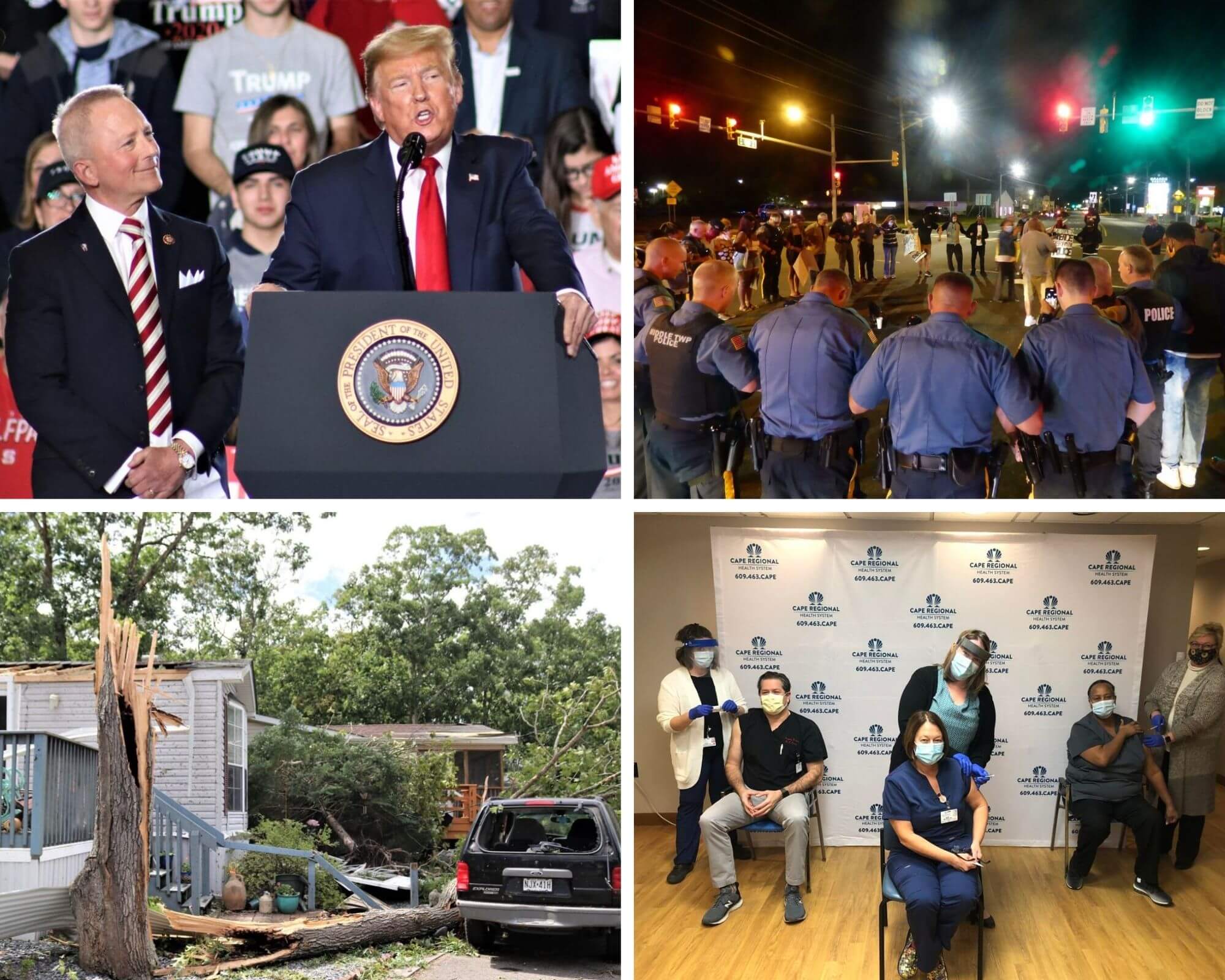COURT HOUSE – The year’s news was dominated by the pandemic, but a surprising number of other issues also held the county’s attention in 2020.
Pre-Covid in Cape May County
There is an ongoing debate about when the SARS-CoV-2, the virus that causes Covid, arrived in the U.S. There is no debate on when the nation became aware of it.
The World Health Organization (WHO) Jan. 9 announced the presence of a mysterious coronavirus-related pneumonia, in Wuhan, China. Less than two weeks later, Jan. 21, the Centers for Disease Control and Prevention (CDC) confirmed the first U.S. case. By the end of the month, Jan. 31, WHO issued a global health emergency.
In Cape May County, the news story that dwarfed others was not about the virus, but rather about the impeachment trial of President Donald Trump and the party switch announced by U.S. Rep. Jeff Van Drew (R-2nd).
The president held a rally, in Wildwood, largely in recognition of Van Drew’s support during the impeachment vote in the House of Representatives.
January is normally one of the quieter months in the county. Second homeowners have left, the shoulder season for tourists is over, and even many permanent residents annually leave for warmer climes.
The rally generated excitement and a large crowd turned out to cheer for Trump. A more modest number showed to protest his appearance.
The presence of the virus in the U.S. had not yet triggered a public alarm. As late as Feb. 29, a state press release had Health Commissioner Judith Persichilli saying, “Most New Jersey residents are at low risk for novel coronavirus.”
Local issues dominated as towns debated and approved plastic bag ordinances, a developer proposed a new Hilton Hotel in a county almost devoid of national chains, many eyes were focused on a changing of the guard, in Wildwood, following municipal elections, and details were being shared about the large off-shore wind farm planned for the South Jersey coastline.
There was even worry over the possible impact of a Route 47 sinkhole’s impact on tourism traffic.
Covid Arrives
By March, news of the virus began to take center stage. The WHO March 11 declared the outbreak a pandemic. Two days later, Trump declared a national emergency, unlocking emergency federal funds to fight the virus. By March 26, Congress passed the CARES Act, appropriating $2 trillion for economic aid to individuals, states, public health departments, small and large businesses, and education.
In New Jersey, Gov. Phil Murphy began issuing executive orders, declaring a public health emergency, restricting activities and issuing a stay-at-home order (March 21), locking down all but essential services. He would issue 27 executive orders by the end of April.
The U.S. Coast Guard Training Center Cape May was busy preparing for the almost certain arrival of Covid.
The transition was jarring. Fear was mounting as dire forecasts of the mortality rate of the virus spread rapidly. The first known Covid case arrived, in Cape May County, March 18, when a 30-year-old man from New York City visited the county. The county confirmed three cases of the virus when the stay-at-home order went into effect.
Fear grew concerning the virus’s impact on the county. The fear was rooted in conflicting projections as testing increased. Political and health officials did not yet have a handle on the disease.
Some in the county began telling nonresidents, even those with second homes here, to stay away. There was talk of closing bridges to all but permanent residents. Others in the county hoped the summer visitors would show up when the season started.
The stories from New York City and North Jersey showed that the virus was rampant outside the county, and many in the county wanted to keep it outside.
As March progressed, schools closed and government meetings moved to virtual settings. The county was still an oasis in the state, ending the month with 26 total confirmed cases and no reported Covid fatalities.
In some towns, the public expressed support for the increased transparency that resulted from virtual meetings and increased access.
There was still energy for other issues, as county officials took sides in the national immigration debates raging around Trump’s policies.
In October 2019, Sheriff Robert Nolan filed litigation to overturn the restrictions on his ability to support Immigration and Customs Enforcement (ICE) efforts in the county jail. The restrictions came in the form of a state attorney general directive. In March 2020, the U.S. Justice Department filed briefs to support Nolan. The directive was upheld by the courts in summer.
April was a cruel month, as the virus hit long-term care facilities with full force. To the north, the death toll continued to rise dramatically. The county experienced its first death April 4, an Upper Township woman. By the end of the month, 21 county residents succumbed to Covid.
With the summer quickly approaching, county officials announced a Business Recovery Task Force. Weekly conference calls between county health officials and municipal mayors began.
Restrictions remained in effect, and some in the county began to resist. Churches were among those who challenged limits on gatherings, citing constitutional guarantees and calling attention to the fact that liquor stores were declared essential businesses, while gathering for worship was banned.
The county was not yet at the point of curbside pickup for non-essential retail. Such retail remained closed and restaurants were limited to takeout only. Nonessential construction was banned, as well.
It was a grim period for the county’s small businesses. Unemployment skyrocketed and municipalities saw major drops in their expected fee revenues.
In May, it was official that the schools would not open for the rest of the academic year.
Lost in the discussions of the pandemic and the measures taken to combat it was the fact that the 10-year census began. The county, always with the state’s lowest participation rate, was off to its usual slow start.
The National Weather Service greeted the imminent arrival of summer with a forecast for an above-normal season for named storms. It would turn out to be a record season, with 30.
The county May 5 sent a reopening plan to the governor, urging a regional approach to easing restrictions. The plan pointed to the fact that the majority of county Covid cases and fatalities were in long-term care facilities and not in the general community. It also emphasized the importance of the summer to the tourist-based economy along the Jersey Shore.
Early praise for the plan, in Trenton, buoyed hopes for acceptance, but in the end, a one-size-fits-all opening strategy was endorsed by the state.
Debates over the efficacy of the malaria drug hydroxychloroquine began, as well as early hopes for Remdesivir, which gained European approval May 1.
In the county, Wildwood Catholic was saved once more, several municipal settlements resulted in high payments to those who sued, and worry grew about the homeless during the pandemic.
By May 28, U.S. deaths from Covid passed 100,000. On that same day, the county’s death toll stood at 47, with 80% of those associated with long-term care facilities.
Summer Begins
County minds were focused on the summer economy. Middle Township Mayor Timothy Donohue said, “We don’t have the option not to reopen Cape May County for the summer. That’s not an option.”
Plans for beach openings were announced. The governor June 3 announced protocols for outdoor dining. Across the county, municipal governing bodies initiated processes to aid restaurants by opening the use of public right of ways and relaxing public consumption regulations.
No one yet knew the extent to which outdoor dining would be one of the hits of 2020 and one of the few positive legacies of the pandemic.
In early June, Murphy lifted the stay-at-home order, as national reports put the number of cases of Covid at 2 million individuals.
New Jersey put a travel advisory in place, listing states from which travelers to New Jersey would be expected to quarantine on their arrival in the state. County officials worried that the advisory would hurt already below par tourist volumes.
George Floyd died while in police custody May 25, setting off nationwide protests that reached the county, in June. Peaceful protests were held from Ocean City to Cape May. An open dialog on policing in the county occurred in several municipalities.
The primary election season was in full swing. Meanwhile, the county had its first look at major changes in the way people would vote, in 2020. Mail-in ballots would lead to higher-than-usual voter participation in the primary and eventually in the general election, in November.
Summer crowds began to build despite the pandemic. The second half of the summer would bring more visitors to the shore communities than anyone expected at the start of the season.
Helping the expanding population grow, several property owners with vacation homes came for extended stays, prompting Stone Harbor Mayor Judith Davies-Dunhour to comment at a council meeting: “There are a lot of people in town.”
Some businesses, still shuttered, continued to fight the restrictions imposed by Trenton. Local movie theater owners joined a lawsuit to force the governor to reopen their venues. The effort was unsuccessful, and they would continue to wait for restrictions to be eased.
Tropical Storm Isaias did its best to confirm the projections of strong storms in the Atlantic this year, even spawning a tornado, in Upper Township. In North Wildwood, the state Department of Environmental Protection cited the city for destructions of dunes and engaging in unauthorized beach work.
Summer saw a noticeable decline in the Covid cases among county residents. Spikes, when they occurred, were largely attributed to crowds of nonresident and resident young people ignoring gathering restrictions. The mortality rate amid the new cases also declined, with health officials citing the younger demographic as part of the cause.
Nationally, cases continued to grow, hitting 3 million as the Fourth of July ended. The largely outdoor nature of activities at the shore may have played a role in the county’s moderate experience during the summer. June, July, and August combined saw less than 500 new cases reported among county residents.
As the summer progressed, second homeowners showed no signs of having short visits. Trash collection volumes, water usage, and the number of calls to public safety departments were at record highs as the crowds came and stayed.
The shore became a place to wait out the worst of the pandemic. The local economy was able to salvage some of the expected summer revenue.
A boom in real estate was fueled by low rates and a desire for space on the part of those who were having second thoughts about urban living. Beach patrols stayed busy for a longer period as towns tried to keep more beach areas protected to accommodate the spread-out beachgoers.
Attention was lost on issues like the plastic bag ordinances, continued problems with recycling costs, and resiliency and climate change concerns. Town governments continued to pay heed to normal governance issues, but an appropriate focus was on efforts to aid local businesses with the allowance of outdoor retail events and continued adjustments to al fresco dining.
By summer’s end, the county released a comprehensive plan to rebuild or rehabilitate 28 bridges, all in desperate need of attention. The plan represented a major investment in the county’s infrastructure.
Fall Sees 2nd Wave
The fall saw a continued presence of many of the county’s second homeowners who were slow to leave, especially with schools in the tri-state area adopting remote learning as a dominant or at least optional environment.
The Stone Harbor Farmer’s Market stayed open longer. Lifeguards enrolled in remote college programs, which kept some beaches open longer.
Schools reopened, with most implementing a combination of in-person and remote instruction programs.
The early evaluation of the summer was that it was better than expected, although a downturn from the record 2019 season. The result was uneven, as some local businesses did well, others saw moderate results and still others failed, with some closing for good.
By mid-October, the cases began to grow again, as people were nudged indoors by the weather. Worries about a second wave were prescient, given what would happen to the case numbers, in November and December, when each of those months would record over 1,000 new cases of Covid infection.
Those last two months produced over 60% of all the county Covid cases since the beginning of the pandemic, in March. Health care workers were hit with the growth in cases.
The general election also claimed center stage, with incumbents doing well, except in Cape May and West Wildwood.
In Cape May, two citizen-initiated referenda competed for votes over the bonding for new facilities for the city’s public safety departments.
The state ballot question on legalizing marijuana was carried by a substantial number of votes.
As winter approached, vaccines emerged with emergency approval from the FDA. Initial projects of the number of doses the state would receive proved to be overestimated, as national distribution logistics hit snags.
The first vaccinations occurred, in December, and the state released an updated vaccination plan Dec. 15 (https://bit.ly/3hoXv7T).
This all came as December became the deadliest month of the pandemic, with 32 Covid-related county fatalities. For the year, 137 residents succumbed to the virus.
Few will regret seeing 2020 in their rearview mirror.
To contact Vince Conti, emailvconti@cmcherald.com.







